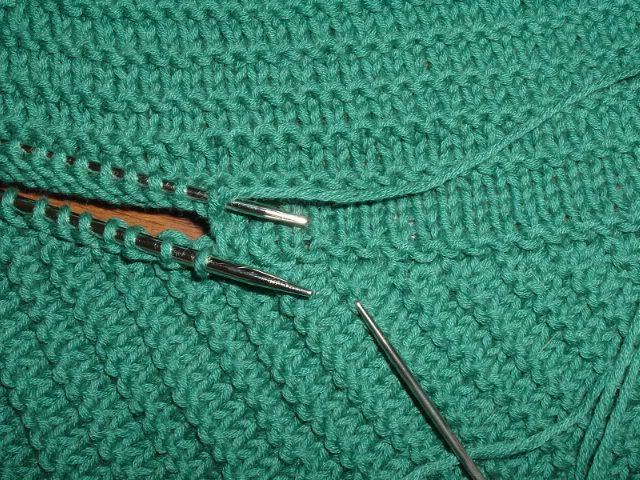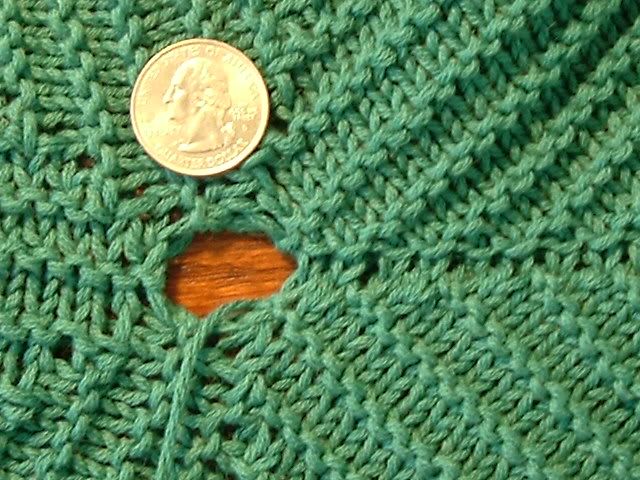Not long ago, I wrote about how bad I am at grafting. Nearly all my attempts at grafting resulted in several "do overs." Part of my troubles with grafting was my inability to understand which way the tapestry needle goes through the loops. I tried using several sets of written directions. I tried following drawings and ignoring the words. But it didn't sink in. Until now. I found Interweave Knits's article titled "Grafting Made Easy."** These directions make so much more sense to me. Instead of saying put the needle in knitwise or purlwise, the article says put the needle down or up through the loops. Plus, it describes how to graft different edges and stitches. I get it now. No do overs this time.
 Look, I'm grafting! I did a provisional cast-on for Curlicue so that I wouldn't have a seam on the outer sections of the blanket. Overall, I'm satisfied with the graft. However, the grafted bit has one more stockinette rows between the garter stitch ridges. The extra row is the grafted row, of course. When I started this thing, I thought that I should do one less stockinette row because I knew grafting would add an extra row. But I would have had to fiddle with the short rows if I had knitted one fewer row and, at the time, I didn't want to think about it too hard. So now I have an extra row. At least I expected it.
Look, I'm grafting! I did a provisional cast-on for Curlicue so that I wouldn't have a seam on the outer sections of the blanket. Overall, I'm satisfied with the graft. However, the grafted bit has one more stockinette rows between the garter stitch ridges. The extra row is the grafted row, of course. When I started this thing, I thought that I should do one less stockinette row because I knew grafting would add an extra row. But I would have had to fiddle with the short rows if I had knitted one fewer row and, at the time, I didn't want to think about it too hard. So now I have an extra row. At least I expected it. For the seam on the inner sections I did what I'm calling a half-graft. I attached the live stitches of the last inner section to the edge of the first inner section. (Do you like how I'm assuming that everyone who reads this is familiar with the pattern? No? Neither do I.) In this part of the blanket, I had to start over once because I forgot to pick up the short row wraps as I grafted, and then I had to start over two more times because I didn't properly line up the live stitches to the rows on the other side. When I finished, I had a huge hole in the middle. Thankfully, I was able to close it up without any puckering.
For the seam on the inner sections I did what I'm calling a half-graft. I attached the live stitches of the last inner section to the edge of the first inner section. (Do you like how I'm assuming that everyone who reads this is familiar with the pattern? No? Neither do I.) In this part of the blanket, I had to start over once because I forgot to pick up the short row wraps as I grafted, and then I had to start over two more times because I didn't properly line up the live stitches to the rows on the other side. When I finished, I had a huge hole in the middle. Thankfully, I was able to close it up without any puckering.I can't decide if grafting was worth it for this blanket. In theory, grafting should make the seam invisible. But in reality, I think the seam is MORE visible on the right side than it would have been if I had simply sewn it. I think I could devise a way to make a grafted seam that was invisible on the right side, but I don't have that kind of motivation right now.
* Isn't it odd that Henry Higgins uses such poor grammar?
** This article can be found in Beyond the Basics in the Subscriber-Only Content part of IK's website.
5 comments:
Hmm. I've done basic kitchener stitch a fair number of times and I can't figure out all at how it can be conceptualized as putting the needle down or up through the loops. I'll go check out that Interweave article and see what kind of nonsense they're talking.
When do we get to see a glamorous finished object picture? Or can you not keep the cats off it long enough to snap it?
By the way, now that I'm famous, this will probably be the last comment that I personally post on your blog. Soon I'll have a staff for that sort of thing.
Grafting does provide a more elastic seam than other seams (at least in my opinion), so perhaps that's why it was indicated for the blanket? Just a thought.
I'm probably just weird, but I really like grafting. I kind of enjoy seaming, too. What did you do to close up the hole? My patches of things like that always look terrible.
Terby, I treaded the end of the yarn trough the edges of the stitches around the hole. Then, I pulled until the hole closed up. Sort of like closing up the top of a hat.
I don't understand the Henry Higgins reference. Obviously I know Pygmalion and My Fair Lady, but I don't get the grammar point you're making
Post a Comment